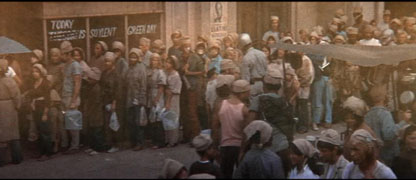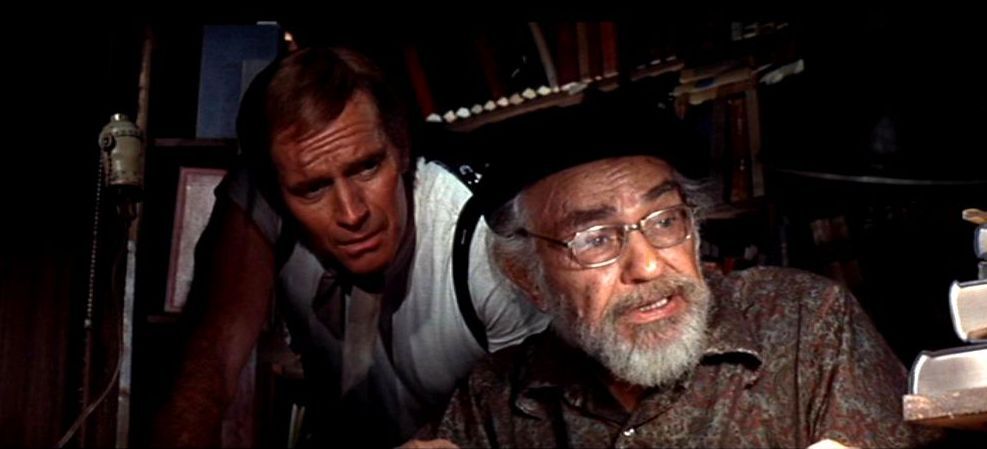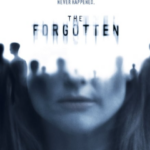Soylent Green (1973)
The year is 2022, and things are rotten. So bad are they, in fact, in this movie that the environment is wrecked, natural resources are depleted, the food supply has run out, the economy is in shambles, and cities are out of housing space for millions of desperate unemployed and homeless people who are left to haunt the streets.

How did things get so awful? You can guess. Economic growth. Mega-pollution from automobiles, the oil companies and big industry, which have combined to create a greenhouse effect that not only leaves everyone sweltering in high temps 24 hours a day, but it has wiped out all but remnants of Earth’s scenic beauty, arable land and even animals.
Those are not even the biggest cause of Earth’s mess, though. For that, you have to look at “overpopulation.” All those people, daring to have children!
This we learn from a propagandistic, dreary montage of black-and-white photos during the film’s opening credits. The images actually depict scenes that are benign and do not prove a thing about people and economic growth being bad for the world: oil fields, factories, temporarily clogged freeways, housing tracts, crowds in bustling cityscapes. Where are photos of all the Earth’s vast rural and wild spaces?
Suspicions to the contrary, Al Gore didn’t write the script for this 1973 film. Neither did Paul Ehrlich, whose 1968 book Population Bomb and its since debunked warnings about mass starvation by the 1970s set off an explosion of anti-life, anti-economic-freedom panic that still resurfaces today. Nor did the Club of Rome write it; their also-discredited 1972 report, “The Limits of Growth,” caused alarums that continue to resound.
Now, in real life we’re in 2018, only four years removed from 2022, and obviously things aren’t anything like what this 1973 movie said they’d be. That should be a lesson to us about the credibility of the prophets of doom from the population control, environmentalist and global warming – er, climate change – pressure groups.
“Soylent Green” is as much if not more a sleazy detective story as it is Green – pun intended – propaganda. Charlton Heston, in not one of his prouder roles, is Det. Thorn, a New York City cop who rooms with elderly and depressive Sol Roth (Edward G. Robinson), one of the city’s human “Books,” civic-minded scholars who research what is happening in society – in Sol’s case, crimes his friend Thorn is trying to solve.

Investigating the murder of Soylent Corp. bigwig William Simonson (Joseph Cotten), Thorn realizes it was no mere burglary but an assassination. Soylent controls food distribution in the city and “half the world” and has an ally in Gov. Santini (Whit Bissell). Is corruption afoot? Does Soylent have secrets? You guessed it: Yes.
An elite dominates in this dystopian 2022 world, and they have access to luxuries such as apartments, running water and meat and vegetables, while everyone else is homeless and has to wait in long lines for rationed water and for supposedly nutritious Soylent Green crackers, which are said to be made from plankton.
During his murder probe, Det. Thorn questions Simonson’s traitorous bodyguard Fielding (Chuck Connors) and naïve Shirl (Leigh Taylor-Young), a concubine attached to Simonson’s apartment – every room in the posh building comes with one. Disgustingly, in a later visit he orders her to bed with him. She complies; that is her job, but she then decides she likes him. Also disgusting are the Hollywood conventions of women falling for men who (a) mistreat them or (b) are old enough to be their fathers.
Figuring Simonson was murdered to silence him, Thorn visits a priest to whom Simonson had gone to Confession recently. The priest, overwhelmed and exhausted by his impossible duties of caring for hundreds of homeless people in his church, tells Thorn nothing except to cryptically mutter the word, “horrible.” Fielding learns of Thorn’s visit and assassinates the priest in the confessional the next day.
Gov. Santini wants Thorn dead, and much of the rest of the film involves Thorn following leads while Fielding tails him, all against a backdrop of people suffering from the ill effects of overpopulation. At one point, Thorn has to step over many sleeping homeless women, each with several tots at their side. Mothers and babies: A problem!
Finally, Sol is horrified after fellow “Books” tell him a terrible secret they’ve learned about the Soylent Corp. At the news he decides to kill himself by going to the city’s assisted suicide center (the tale gets more modern as it goes), where forlorn old people stand in line to sign away their lives and have attendants escort them to the death chamber. Sol has left a note for Thorn that he is “Going Home” – society’s euphemism for suicide by drinking a fatal drug cocktail.
Thorn rushes to the euthanasia center too late, but still in time for the dying Sol to try to tell him what Soylent Green really is. They tell each other, “I love you” – this is clearly non-sexual – and Thorn’s face reflects the ghastliness of what he is seeing.
SPOILER ALERT: Thorn discovers shrouded bodies being taken away in garbage trucks to a Soylent Center where they are processed into the Soylent Green crackers. Police wound him, and Fielding tracks him to the church. Thorn kills Fielding, but the police cart him away as he shouts, “Soylent Green is made of people! Soylent Green is people! We’ve gotta stop them!”

Ironically, the film is a perfect picture of what socialism, not economic freedom, does to a country: shortages, rationing, environmental damage and the devaluing of human life (e.g., the socialist dictator Maduro’s suffering Venezuela).
Richard Fleischer directed. Stanley R. Greenberg wrote the screenplay, based on Harry Harrison’s 1966 novel, Make Room! Make Room! Music by Fred Myrow and cinematography by Richard H. Kline. The MPAA rating is PG, but that includes several sexual scenes (no overt intercourse), bad language, shootouts, beatings, euthanasia and mass brutality against crowds of people.
— Dan Engler













